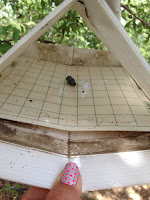This
time of year cotton fields start turning the corner from a sea of pink, yellow
and white flowers to an ocean of lush green bolls.
 |
| Here is a close-up photo of aphids. -- UC IPM Photo |
Lurking in the background, though, are pests that
can damage the crop and inflict economic pain. Field scout Carlos Silva reports
cotton aphids are taking center stage on the pest front right now in a number
of fields, particularly in the Firebaugh region of Fresno County.
About
of third of the cotton plant leaves he has inspected are infested with aphids.
“Growers are starting to think about how they may need to get rid of the pest,”
Carlos says.
Aphids can be found throughout the season and cause
different kinds of problems during the growth stage of the cotton plant. During
the spring, heavy aphid populations can cause leaves to crinkle and stunt
seedling growth.
 |
| Aphids are found on the back of a cotton plant leaf. |
Carlos says growers need to be vigilant with their
monitoring programs. UC IPM says it’s important for growers to be aware of both
the number of aphids and the color of the pests. Small yellow aphids develop
slowly from nymphs to adults and don’t produce many offspring. As a result,
their populations don’t increase quickly. On the other hand, darker green and
black aphids reproduce rapidly and their populations can explode.
Natural enemies such as parasitic wasps, minute
pirate bugs, bigeyed bugs and green lacewings can help control aphids. “There
are a lot of green lacewings in the fields,” Carlos says.
 |
| Honeydew residue creates a sheen on a cotton plant leaf. |
However natural enemies won’t be enough to tackle a
heavy aphid infestation. But chemical treatment isn’t a simple solution. Here’s
what UC IPM says:
“Chemical management of cotton aphid can be
extremely erratic and unpredictable. Part of the problem is that cotton aphid
has developed resistance to many chemical classes, including organochlorine,
organophosphate, carbamate, and pyrethroid insecticides. In addition, these
broad-spectrum pesticides kill the natural enemies of the cotton aphid. Another
resistance concern is with the neo-nicotinoid insecticides. Repeated
applications of any neonicotinoids can result in resistance to all
neo-nicotinoids.”
 |
| Parasitic wasps can help control aphids. -- UC IPM photo |
Overall, cotton development is progressing well. Growers are irrigating their fields for the third time this season. The plants are at about 12 to 13 fruiting branches.
In alfalfa, growers are preparing for another harvest. So far, it appears many growers have enough water available for another cutting.
Carlos reminds growers to continue leaving strips of uncut alfalfa to create a habitat for lygus bugs and keep them migrating to nearby cotton fields. “There still is a lot of lygus in the alfalfa fields,” he notes.













